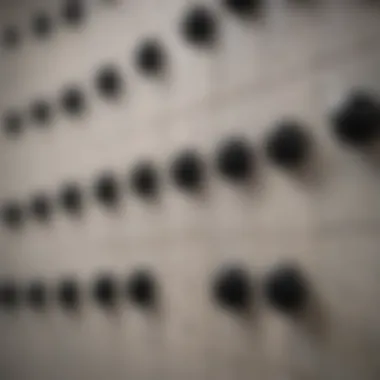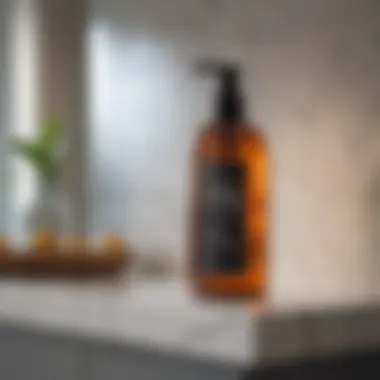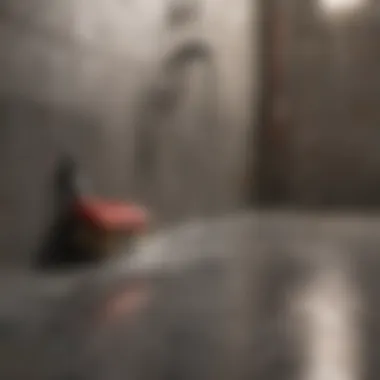Effective Strategies for Removing Black Spots in Your Shower


Intro
Maintaining a clean shower can be challenging, especially when unwanted black spots appear. These unsightly marks are often the result of mold or mildew growth. With the right knowledge and approaches, homeowners can effectively tackle this problem and restore their bathing space to its original state. This article aims to provide practical strategies that not only remove these spots but also prevent them from returning. The focus will be on understanding the root causes of black spots, exploring various cleaning methods, and introducing maintenance tips for long-term hygiene.
Design Inspiration
Creating a beautiful and functional bathroom space involves more than just aesthetics; it also requires attention to cleanliness. An inviting shower area enhances the overall design of your bathroom. Here, we’ll explore trending styles that complement clean, spot-free showers.
Trending Styles
In modern homes, minimalism and functionality are popular. Sleek lines, clean surfaces, and adequate lighting contribute to a fresh appearance. Shower stalls with glass doors or open designs are increasingly favored. These styles not only make the space feel larger but also facilitate easier cleaning. Additionally, incorporating moisture-resistant materials, such as ceramic tiles or natural stone, helps maintain a pristine look for longer periods.
Color Palettes
When selecting colors for your bathroom, consider shades that evoke cleanliness. Light colors, like whites and soft pastels, can make a shower feel airy and fresh. However, darker colors can similarly work well when paired with proper lighting and maintenance strategies.
Prioritizing specific color choices can also support the illusion of cleanliness. Avoid colors that might disguise spots or stains, as they can compromise your efforts in maintaining a spotless shower.
Practical Tips
Understanding how to prevent and remove black spots is essential. Here, practical maintenance tips are provided to ensure ongoing cleanliness in your shower space.
Maintenance & Care
Regular cleaning practices significantly influence the longevity of a clean shower. Here are some essential tips:
- Use a squeegee after each use to remove excess water from surfaces.
- Ventilation is crucial. Ensure your bathroom is well-ventilated to minimize humidity.
- Select proper cleaning agents, such as vinegar or specific mildew removers, to address stains effectively.
Incorporating routine cleaning into your schedule helps combat mold and mildew before they become noticeable spots. Establishing a monthly deep cleaning ritual can also greatly enhance the hygiene and aesthetic appeal of your bathing space.
Budgeting & Planning
Keeping your shower clean does not need to be expensive. With thoughtful planning, one can manage costs efficiently. Here are sensible tips:
- DIY solutions can often be more cost-effective. For example, a mixture of vinegar and baking soda works wonders and is budget-friendly.
- Invest in multifunctional products to minimize clutter and maximize space in your cleaning cupboard.
- Regular maintenance can save money long-term by preventing large-scale mold problems that may require professional cleaning services.
By combining these insights with practical cleaning methods, homeowners can cultivate a spotless shower environment. Through consistent care, one can not only remove black spots but also sustain a welcoming and hygienic bathing space for all.
Understanding Black Spots in the Shower
Black spots in the shower present more than just aesthetic concerns. They indicate underlying issues that can compromise hygiene and overall health. Understanding these spots is essential for any homeowner seeking to maintain a clean, inviting bathing space. This section will delve into what black spots are and explore their common causes, providing valuable insights for effective removal strategies.
Defining Black Spots
Black spots often manifest as unsightly marks on shower walls, tiles, and grout. They can range from small dots to larger patches, making the space seem neglected. More than just dirt, these markings frequently signal the presence of mold or mildew. Recognizing them as more than surface-level blemishes is key to addressing the root problem.
Common Causes of Black Spots
Understanding the common causes of black spots is fundamental to their effective removal. Each cause contributes differently to the formation of these stains, with distinct characteristics and solutions.
Presence of Mold
Mold typically thrives in warm, damp environments. In the shower, it finds ideal conditions owing to humidity and limited air circulation. One of the most concerning aspects of mold is its rapid growth potential, leading to severe infestations if not addressed. Mold can be particularly stubborn, often requiring specific cleaning methods that penetrate its spores. Regular inspections can help catch mold before it becomes a significant issue.
Accumulated Soap Scum
Soap scum arises from the residue left behind after cleansing products mix with hard minerals found in water. Its presence can create a cloudy layer over surfaces, providing a suitable breeding ground for bacteria and mold. Soap scum can be an ongoing problem, especially in households that use bar soap compared to liquid options. To combat this, regular cleaning routines can effectively minimize buildup and maintain a clearer shower environment.


Hard Water Deposits
Hard water deposits result from minerals such as calcium and magnesium present in water. Over time, these minerals accumulate and form unsightly marks on surfaces. Hard water is particularly notorious for obstructing the effectiveness of your cleaning efforts, as it can create a rough texture that traps other residues. Addressing hard water issues may involve using specific descalers or water softeners. Identifying hard water as a contributor to black spots strengthens your approach to maintaining a clean shower.
Assessing the Situation
Assessing the situation regarding black spots in your shower is crucial before attempting any cleaning solutions. Understanding the specifics allows homeowners to tailor their approach, which can lead to more efficient cleaning and better long-term results. Each type of surface and the extent of the staining can dictate different cleaning methods, products, and techniques.
This section covers two primary facets: identifying the surface materials in your shower and evaluating the extent of the stains. Knowing what you are dealing with not only helps in choosing the right cleaning solution but also aids in preventing future occurrences of black spots.
Identifying the Surface
Tile vs. Acrylic
Tile surfaces are common in many bathrooms, known for their durability and aesthetic appeal. They are available in various materials such as ceramic or porcelain. On the other hand, acrylic is a popular choice for modern showers, being lightweight and easy to install.
The key characteristic of tile is its resistance to stains when properly sealed. However, grout lines can be a vulnerability where mold might grow. Acrylic surfaces, while easier to maintain, can be prone to scratching, which might harbor bacteria.
One unique feature of tile is its ability to handle high temperatures and moisture. This makes tile a beneficial choice for bathrooms. However, deep cleaning grout requires specific techniques and products.
In comparison, acrylic is easier to wipe down, as it has a smoother surface. But in terms of longevity and aesthetic variety, tile could be a better investment.
Grout Considerations
Grout plays a pivotal role in the overall integrity of tiled surfaces. It is a porous compound that can absorb water and dirt, making it a common breeding ground for mold and mildew. The key characteristic of grout is its permeability, which requires regular maintenance to prevent staining.
Why is grout so important? The unique feature of grout is that it seals the spaces between tiles, forming a protective barrier. If the grout becomes compromised, water can penetrate, leading to deeper mold issues that might be harder to eradicate.
In this article, understanding grout and its maintenance can significantly affect the cleanliness of your shower. Hence, knowing if you have epoxy or traditional grout can influence the cleaning methods you choose, which will be discussed later.
Evaluating the Extent of the Stains
Superficial Marks
Superficial marks indicate less severe staining and typically reside on the surface of the material. These might stem from soap scum or light mold growth. The key characteristic of superficial marks is that they are often easier to remove with routine cleaning products.
Why focus on these marks? Addressing them early can prevent further damage and deeper staining, making it a beneficial practice for maintaining a cleaner space over time.
These marks often do not require heavy-duty chemicals, and a simple solution may suffice. Efficient cleaning can mean less hassle in the future.
Deep-rooted Mold
Deep-rooted mold can be a serious issue that demands more attention. This type is likely developed in areas where moisture is consistently present, often found in grout lines or behind tiles. The key characteristic here is the persistence of mold; it penetrates surfaces and can spread if not addressed.
Understanding that deep-rooted mold can lead to health risks makes tackling it urgent. It also signifies that routine cleaning can no longer suffice, thus requiring specialized cleaning agents and techniques.
As with any persistent issue, resolving deep-rooted mold can often involve ongoing maintenance work and a commitment to more thorough cleaning methods than merely wiping down surfaces.
Essential Cleaning Supplies
To effectively remove black spots in your shower, having the right cleaning supplies is crucial. The proper tools and agents can make the cleaning process more efficient and achieve better results. Selecting effective products is a balance between potency in removing stains and safety for the surfaces they are applied to. Understanding the types of cleaning agents available will help homeowners adapt their cleaning strategy to achieve optimal cleanliness without damaging the materials of their shower.
Commercial Cleaners
Commercial cleaners are widely available and can be powerful allies in fighting black spots in showers. They are specifically formulated for various surfaces, ensuring effective removal of stubborn stains.
Specific Cleaning Agents for Grout


Specific cleaning agents for grout are designed with harsh yet effective ingredients that target mildew and mold. These cleaners penetrate deep into the porous material of grout lines, breaking down stains and preventing further growth. A key characteristic is their ability to tackle not just surface stains but also deeper discolorations that have built up over time. Many homeowners find these products beneficial due to their targeted formulation, which can often yield quick results. However, it’s important to note that some specific cleaners might contain strong chemicals that require caution during application.
Multi-surface Cleaners
Multi-surface cleaners provide versatility and convenience, allowing users to clean various areas of the shower with a single product. They are designed to tackle diverse surfaces such as tiles, fixtures, and glass. A key feature is their all-in-one capability, which reduces the need for multiple cleaners. This makes them an appealing choice for those looking to streamline their cleaning routine. Nevertheless, while multi-surface cleaners are convenient, they may not be as effective on deep-set stains as specialized cleaners.
Homemade Cleaning Solutions
For those who prefer a more natural approach, homemade cleaning solutions offer an eco-friendly alternative. They are often composed of easily accessible ingredients that can be just as effective as commercial products.
Baking Soda and Vinegar Mixture
The baking soda and vinegar mixture stands out for its simplicity and effectiveness. This combination is a classic for tackling stubborn stains due to a chemical reaction that occurs when they blend. A key characteristic is the fizzing action that helps lift dirt and grime, making it easier to wipe away. Many homeowners find it beneficial as it is non-toxic and safe for various surfaces in the home. However, achieving the best results requires patience, as it may take multiple applications for deeply embedded stains.
Hydrogen Peroxide Solution
Hydrogen peroxide solution is another powerful, yet gentle cleaner. It acts as an oxidizing agent that can kill mold spores and tackle discolorations effectively. A unique feature is its ability to whiten and brighten surfaces, which can enhance the overall appearance of showers. Users appreciate hydrogen peroxide because it is less harsh compared to bleach. Still, care must be taken to avoid prolonged contact with colored surfaces, as it may cause fading or discoloration.
Step-by-Step Cleaning Process
The cleaning process is crucial when it comes to tackling black spots in the shower. It provides a structured approach that ensures thorough removal of mildew, soap scum, and other stains. A step-by-step method contributes to effectiveness and simplicity. Each phase of the process addresses particular aspects of cleaning, reducing the chances of missing spots and ensuring no residual stains linger.
Preparation and Safety Precautions
Gathering Supplies
Gathering supplies is the first step in effectively addressing black spots in the shower. This process involves collecting all necessary tools and cleaning agents before starting. The key characteristic of gathering supplies is the organization it brings. It allows a systematic approach, minimizing interruptions while cleaning. For this article, having the right supplies means more than just cleaners. It includes brushes, cloths, and even buckets.
A popular choice for gathering supplies includes multi-surface cleaners and scrubbing brushes. They efficiently tackle various surfaces and stains present in showers. One unique feature is that specialized cleaning agents often target specific stains. For example, mold removers can penetrate deep for thorough cleaning. However, sometimes these cleaners might contain harsh chemicals. Therefore, consider factors such as safety and environmental impact when choosing products.
Wearing Protective Gear
Wearing protective gear is an essential safety measure during the cleaning process. It helps ensure the individual's safety against harmful substances that may arise from cleaning agents. The key characteristic is its role in personal safety. Gloves, goggles, and masks are crucial pieces of protective gear. Wearing them is a wise practice in every cleaning scenario.
One advantage of wearing protective gear is that it safeguards against skin irritation and inhalation of fumes. A unique feature is that safety goggles ensure clear visibility while using sprays and other cleaning solutions. Some might consider it an inconvenience, but in reality, it eliminates potential hazards, making cleaning more effective and less stressful.
Application of Cleaning Solutions
Using Sprays and Pastes
Utilizing sprays and pastes is a fundamental part of the cleaning process. These methods allow for targeted application on specific areas affected by black spots. The versatility of both options is notable. Sprays can cover large areas quickly, while pastes can cling to surfaces for more profound cleaning actions.
The benefit of using sprays lies in their convenience. They provide a quick and easy application method, making them suitable for everyday use. Pastes, however, hold the cleaning solution on the stain longer. A unique benefit of pastes is their ability to penetrate stubborn stains owing to their thicker consistency. Nevertheless, they might require additional scrubbing for complete removal, which can be time-consuming for some.
Scrubbing Techniques
Scrubbing techniques play a vital role in the cleaning process. Proper techniques ensure effective removal of stains and prevent further damage. The key characteristic here is using appropriate tools, like sponges and brushes, in a suitable manner. It is a beneficial choice for those aiming to maintain a clean shower.
One unique feature of effective scrubbing techniques is the approach of working in circular motions. This method tends to lift dirt more efficiently than linear scrubbing. However, scrubbing too hard can damage sensitive surfaces like grout. A balanced approach is necessary to ensure effectiveness while safeguarding the integrity of the shower's finish.
Rinsing and Drying
Ensuring Thorough Rinse
Ensuring a thorough rinse is the next critical step in the cleaning process. It involves washing away cleaning agents and residue after scrubbing. This practice is key to preventing buildup that can lead to more black spots. The key characteristic is the complete removal of substances that can attract future stains.
A thorough rinse typically involves warm water, which helps in breaking down any remaining residues. A unique feature of this step is that it protects both the material of the shower and the person cleaning it by minimizing slippery surfaces after cleaning. Failing to rinse adequately can lead to unappealing residue and potential health issues, making this a step not to overlook.


Proper Drying Methods
The final step involves proper drying methods. Drying the surfaces after rinsing prevents water spots and reduces mold chances. The key characteristic of drying is that it also inhibits the growth of new black spots. A good choice for drying involves using microfiber cloths as they absorb better than traditional towels.
One unique aspect of proper drying is the technique of airflow management—ensuring the bathroom is well-ventilated after cleaning. This promotes quicker drying while reducing humidity levels that foster mold growth. If left damp, surfaces can become breeding grounds for mildew, which directly contradicts the initial goal of maintaining a clean environment. Properly timed drying is essential to the long-term cleanliness of your shower.
Post-Cleaning Maintenance
Maintaining the cleanliness of your shower after successfully removing black spots is crucial. The post-cleaning phase is not just about achieving a clean appearance; it is about preventing future occurrences of those unsightly stains. By instituting a regular maintenance plan, you will ensure your shower remains fresh, hygienic, and visually appealing. This section emphasizes that the effort to remove stains should be matched with consistent maintenance practices, as this will lead to long-term relief from the bothersome issue of black spots and mold.
Establishing a Cleaning Routine
Frequency of Cleaning
Setting a specific frequency for cleaning can greatly benefit the overall cleanliness of your shower. A weekly cleaning schedule is often recommended. This consistent approach helps in managing soap scum and any potential mold growth before it becomes a more significant problem. Weekly maintenance can be a beneficial practice since it reduces accrued grime and keeps the space hygienic.
A unique aspect of regular cleaning is its psychological effect. By keeping the shower consistently clean, homeowners can feel more comfortable and relaxed. However, if not done frequently enough, say bi-weekly or monthly, you may find that a buildup occurs again, making future cleaning more difficult.
Preventative Measures
Preventative measures are essential in maintaining the hygiene of any bathing space. Simple steps, such as using a squeegee after each shower, can greatly minimize water accumulation and reduce mold growth. Implementing these measures regularly can be a valuable habit.
These practices work because they prevent soap scum and moisture from settling on surfaces. However, some individuals may find these methods inconvenient or tedious, which can lead to inconsistency. On the other hand, when applied regularly, preventative measures effectively lower the chances of mold and mildew re-developing, preserving the state of cleanliness achieved after deep cleaning.
Choosing the Right Products
Best Practices for Mold Prevention
Utilizing effective mold prevention strategies is key. This can include using mold-resistant shower curtains or applying mold-resistant paint on walls. These practices not only help fight mold growth but also enhance the longevity of your shower space.
The primary strength of these practices lies in their long-lasting effects. They can create barriers against moisture, which is vital in preventing mold. The downside is the initial upfront costs associated with these products, but the long-term savings on cleaning products and effort can make them worth the investment.
Selecting Suitable Cleaning Agents
Selecting appropriate cleaning agents can be of great importance in your maintenance routine. It is vital to choose products specifically designed to address black spots and mold. For example, products containing hydrogen peroxide or oxygen bleach are useful because they effectively combat the roots of mold growth.
Opting for eco-friendly cleaning solutions can be a popular choice among homeowners. These products often lack harsh chemicals, making them safer for the environment and users alike. However, some might find that eco-friendly products can require more frequent application due to their gentler cleaning agents.
In summation, successful and lasting maintenance of your shower space hinges on the combination of a regular cleaning schedule, preventative measures, and the conscious selection of cleaning agents. By adopting these strategies, homeowners can ensure their showers remain inviting and free from the nuisance of black spots.
End
In concluding this guide, it is essential to recognize the comprehensive nature of maintaining a clean and hygienic shower environment. Addressing black spots effectively is not merely about aesthetics; it is also a matter of health and well-being. The presence of mold and mildew can lead to respiratory issues and unpleasant odors, affecting the overall experience of using your bathing space. Moreover, the dedication to cleanliness reflects a commitment to personal care and home maintenance.
Recap of Effective Practices
Throughout this article, several key practices have been highlighted to aid in the removal of black spots. First and foremost, understanding the specific causes of these marks—ranging from mold presence, soap scum, and hard water deposits—is critical in addressing the problem effectively.
Here are the primary strategies to take away:
- Regular Cleaning: Establish a routine to ensure cleaning is done frequently. This helps in preventing the buildup that leads to black spots.
- Use Appropriate Cleaning Agents: Choose the right products, whether commercial cleaners or homemade solutions like vinegar and baking soda. Their application should be based on the type of surface being cleaned.
- Thorough Rinsing: After using cleaning solutions, always rinse the surfaces thoroughly. This not only removes residual cleaning agents but also prevents potential staining.
- Drying the Area: After cleansing, it is beneficial to dry the surfaces to decrease moisture, which contributes to further mold growth.
Implementing these practices will undoubtedly enhance the longevity of your shower’s cleanliness and beauty.
Final Thoughts on Maintaining Cleanliness
Lastly, the focus should not only be on addressing existing black spots but also on instilling habits that prevent their recurrence. Regular maintenance, careful selection of cleaning products, and being mindful of moisture levels can go a long way.
For homeowners and design enthusiasts, the goal is to create an inviting and hygienic shower space. This not only enriches the daily bathing experience but also reflects a high standard of personal hygiene and home care.
"Commit to a culture of cleanliness and transform your bathing space into a sanctuary of serenity and health."
By adopting these strategies and understanding their importance, you ensure that your shower remains a pleasant space, free from the distressing presence of black spots.















